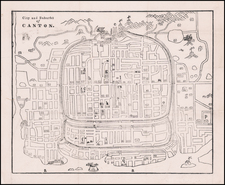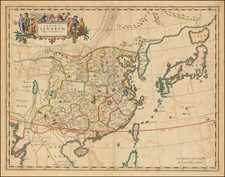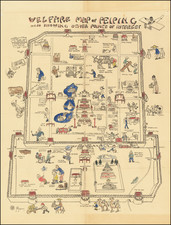Fine large view of the Summer Palace, Longevity Hill and Kunming Lake, with photographs and tourist information on the verso.
Summer Palace
The Summer Palace is a vast collection of lakes, gardens and palaces in Beijing. It was an imperial garden in the Qing dynasty. Mainly dominated by Longevity Hill and Kunming Lake.
Longevity Hill is about 200 feet high and has many buildings positioned in sequence. The front hill includes halls and pavillions, while the back hill is quiet with natural beauty. The central Kunming Lake was entirely man-made and the excavated soil was used to build Longevity Hill.
In December 1998, UNESCO included the Summer Palace on its World Heritage List. It declared the Summer Palace "a masterpiece of Chinese landscape garden design. The natural landscape of hills and open water is combined with artificial features such as pavilions, halls, palaces, temples and bridges to form a harmonious ensemble of outstanding aesthetic value".
The origins of the Summer Palace date back to the Jurchen-led Jin dynasty in 1153, when the fourth ruler, Wanyan Liang (r. 1150–1161), moved the Jin capital from Huining Prefecture (in present-day Acheng District, Harbin, Heilongjiang) to Yanjing (present-day Beijing). He ordered the construction of a palace in the Fragrant Hills and Jade Spring Hill in the northwest of Beijing.
Around 1271, the engineer Guo Shoujing initiated a waterworks project to direct the water from Shenshan Spring (神山泉) in Baifu Village (白浮村), Changping into the Western Lake (西湖), which would later become Kunming Lake, to create a water reservoir that would ensure a stable water supply for the palace.
In the early Qing dynasty, Jar Hill served as the site for horse stables in the imperial palace. In the beginning of the reign of the Qianlong Emperor (r. 1735-1796), many imperial gardens were built in the area around present-day Beijing's Haidian District and accordingly, water consumption increased tremendously. At the time, much of the water stored in the Western Lake came from the freshwater spring on Jade Spring Hill, while a fraction came from the Wanquan River (萬泉河). Any disruption of the water flow from Jade Spring Hill would affect the capital's water transport and water supply systems.
Around 1749, the Qianlong Emperor decided to build a palace in the vicinity of Jar Hill and the Western Lake to celebrate the 60th birthday of his mother, Empress Dowager Chongqing. In the name of improving the capital's waterworks system, he ordered the Western Lake to be expanded further west to create two more lakes, Gaoshui Lake (高水湖) and Yangshui Lake (養水湖). The Qianlong Emperor collectively named the three lakes "Kunming Lake" after the Kunming Pool (昆明池) constructed by Emperor Wu (r. 141–187 BCE) in the Han dynasty for the training of his navy. The Summer Palace, whose construction was completed in 1764.
As the Qing Empire started declining after the reign of the Daoguang Emperor (r. 1820–1850), the Summer Palace gradually became more neglected and the architectural features on the three islands were ordered to be dismantled because the costs of maintenance were too high.
In 1912, following the abdication of the Puyi, the Last Emperor, the Summer Palace became the private property of the former imperial family of the Qing Empire. Two years later, the Summer Palace was opened to the public and entry tickets were sold. In 1924, after Puyi was expelled from the Forbidden City by the warlord Feng Yuxiang, the Beijing municipal government took charge of administrating the Summer Palace and turned it into a public park.
After 1949, the Summer Palace briefly housed the Central Party School of the Communist Party of China. Many of Mao Zedong's friends and key figures in the Communist Party, such as Liu Yazi and Jiang Qing, also lived there. Since 1953, many major restoration and renovation works have been done on the Summer Palace, which is now open to the public as a tourist attraction and park.











![[Hong Kong / Macao / Canton] Asie No. 98. Partie de La Chine](https://storage.googleapis.com/raremaps/img/small/64115.jpg)
![[Macao, Hong Kong & Environs] Carte de L'Entree de la Riviere De Canton dans la Chine](https://storage.googleapis.com/raremaps/img/small/74473.jpg)



